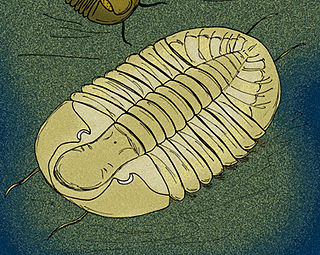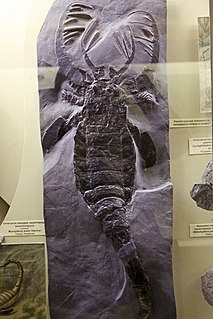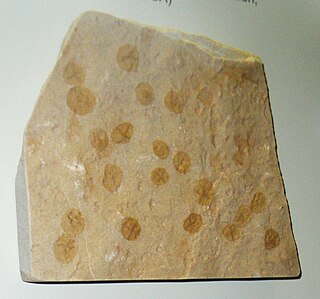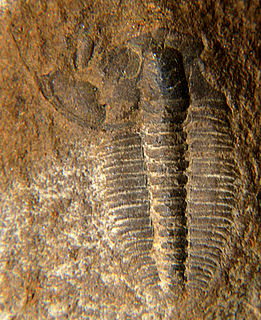 W
WAphaneramma is an extinct genus of temnospondyl amphibian. It lived during the Early Triassic epoch. Fossils have been found in the Mianwali Formation of Pakistan, Madagascar, the Zhitkov Formation of Russia, and the Kongressfjellet Formation of Svalbard (Norway). Aphaneramma grew up to 2 metres (6.6 ft) long, with a 23 centimetres (9.1 in) skull. Aphaneramma's jaws were very long, similar to the gharial's, and lined with small teeth. This adaptation suggests it may have preyed on fish. A marine lifestyle for this animal was proposed. Aphaneramma is closely related to Cosgriffius from North America,
 W
WAteleaspis is an extinct genus of primitive ostracoderm fish that lived in the Early Silurian to Early Devonian periods. Like other ostracoderms, Ateleaspis had a head shield similar to that of Cephalaspis. Species from Silurian period were found in Norway and Scotland, but now has been found also in Siberia from Early Devonian period.
 W
WAtrypa is a genus of brachiopod with shells round to short egg-shaped, covered with many fine radial ridges, that split further out and growthlines perpendicular to the costae and 2-3 times wider spaced. The pedunculate valve is a little convex, but tends to level out or even become slightly concave toward the anterior margin. The brachial valve is highly convex. There is no interarea in either valve. Atrypa was a cosmopolitan and occurred from the late Lower Silurian (Telychian) to the early Upper Devonian (Frasnian). Other sources expand the range from the Late Ordovician to Carboniferous, approximately from 449 to 336 Ma. A proposed new species, A. harrisi, was found in the trilobite-rich Floresta Formation in Boyacá, Colombia.
 W
WBalnibarbi is an extinct genus of trilobites in the family Olenidae. They are known from fossils excavated in Norway. They lived during the early part of the Arenig stage of the Ordovician Period, a faunal stage that occurred about 479 to 472 million years ago.
 W
WCloacaspis is an extinct genus of Olenid Ptychopariid trilobite. It lived during the early part of the Arenig stage of the Ordovician Period, a faunal stage which lasted from approximately 478 to 471 million years ago. Richard Fortey has proposed that these particular trilobites lived in anoxic regions of the ocean floor, and cultivated symbiotic, sulfur-metabolizing bacteria.
 W
WElegantaspis reticornis is an arthrodire placoderm fish, which lived during the Early Devonian period in Spitsbergen, Norway.
 W
WFavosites is an extinct genus of tabulate coral characterized by polygonal closely packed corallites. The walls between corallites are pierced by pores known as mural pores which allowed transfer of nutrients between polyps. Favosites, like many corals, thrived in warm sunlit seas, feeding by filtering microscopic plankton with their stinging tentacles and often forming part of reef complexes. The genus had a worldwide distribution from the Late Ordovician to Late Permian.
 W
WGeragnostus is a genus of very small agnostid trilobites whose fossils are found Ordovician-aged marine strata from Eurasia, North America and Argentina.
 W
WGog is a genus of large, flattened asaphid trilobite from the Middle Arenig-aged Svalbard, Valhallfonna Formation, Olenidsletta, Member, of Spitzbergen, Norway, and the Upper Arenig-aged Dawan Formation in Hubei, China.
 W
WGog is a genus of large, flattened asaphid trilobite from the Middle Arenig-aged Svalbard, Valhallfonna Formation, Olenidsletta, Member, of Spitzbergen, Norway, and the Upper Arenig-aged Dawan Formation in Hubei, China.
 W
WHalysites is an extinct genus of tabulate coral. Colonies range from less than one to tens of centimeters in diameter, and they fed upon plankton.
 W
WHomosteus is a genus of flattened arthrodire placoderm from the Middle Devonian. Fossils are found primarily in Eifelian-epoch aged strata of Europe, Canada, Greenland, and Estonia. All of the species had comparatively large, flattened heads with, as suggested by the upward opening orbits, upward-pointing eyes. These adaptations suggest that the various species were benthic predators. A study on Titanichthys, in contrast, suggests that species of Homosteus may have been filter-feeders instead.
 W
WLeptaena is an extinct genus of mid-sized brachiopod that existes from the Dariwilian epoch to the Emsian epoch, though some specimens have been found in strata as late in age as the Tournasian epoch. Like some other Strophomenids, Lepteana were epifaunal, meaning they lived on top of the seafloor, not buried within it, and were suspension feeders.
 W
WLeptolepis is an extinct genus of teleost fish that lived in freshwater and marine environments from the Middle Triassic period until the Early Cretaceous. The genus is one of the earliest recognized teleost genera.
 W
WLonchodomas is a genus of trilobites, that lived during the Ordovician. It was eyeless, like all raphiophorids, and had a long straight sword-like frontal spine, that gradually transforms into the relatively long glabella. Both the glabellar spine and the backward directed genal spines are subquadrate in section. Lonchodomas has five thorax segments and the pleural area of the pygidium has two narrow furrows. Lonchodomas occurred in what are today Argentina, Canada (Newfoundland), Estonia, Latvia, Norway, Sweden, the Russian Federation and the United States.
 W
WMarocella is a conical shelly fossil of uncertain affinity known from Cambrian strata of Europe, Morocco, Australia and Antarctica.
 W
WMedusinites is a genus of disc shaped fossilised organisms associated with the Ediacaran biota. They have been found in rocks dated to be 580 to 541 million years old.
 W
WMixopterus is a genus of eurypterid, an extinct group of aquatic arthropods. Fossils of Mixopterus have been discovered in deposits from Late Silurian age, and have been referred to several different species. Fossils have been recovered from two continents; Europe and North America.
 W
WNimbia occlusa is a form of Ediacaran fossil shaped like a circular or oval disk, with a thick rim around the margin. Within the rim the fossil is usually flat, but may have a central nipple or dimple. These fossils were generally believed to be those of cnidarians, but they have since been reinterpreted as structures made by microbial colonies. They can reach up to 6 cm in diameter, with a centimeter-thick rim. Some fossils are distorted.
 W
WOlenus is a genus of Upper Cambrian ptychopariid trilobite.
 W
WOmphalosaurus is an extinct genus of marine reptile from the Early Triassic to Middle Triassic, thought to be in the order of Ichthyosauria. Most of what is known about Omphalosaurus is based on multiple jaw fragments, ribs, and vertebrae. Specimens of Omphalosaurus have been described from the western United States, Germany, Austria and the island of Spitsbergen off the northern coast of Norway.
 W
WPlanolites is an ichnogenus found throughout the Phanerozoic that is made during the feeding process of worm-like animals. The traces are generally small, 1–5 mm (0.039–0.197 in), unlined, and rarely branched, with fill that differs from the host rock.
 W
WPlateosaurus is a genus of plateosaurid dinosaur that lived during the Late Triassic period, around 214 to 204 million years ago, in what is now Central and Northern Europe and Greenland, North America. Plateosaurus is a basal (early) sauropodomorph dinosaur, a so-called "prosauropod". As of 2011, two species are recognised: the type species P. engelhardti from the late Norian and Rhaetian, and the slightly earlier P. gracilis from the lower Norian. However, others have been assigned in the past, and there is no broad consensus on the species taxonomy of plateosaurid dinosaurs. Similarly, there are a plethora of synonyms at the genus level.
 W
WPlatystrophia is an extinct genus of brachiopods that lived from the Ordovician to the Silurian in Asia, Europe, North America, and South America. It has a prominent sulcus and fold. It usually lived in marine lime mud and sands.
 W
WPliomera is a genus of trilobites that lived during the Middle Ordovician on the paleocontinent Baltica, now Norway, Sweden, Estonia and the Russian Federation, and in Argentina. It can be recognized for its pentagonal glabella widest between the frontal corners, with an inverted V-shaped occipital ring. In front of the occipital furrow that crosses the entire glabella, two pairs of dead-ending furrows create three side lobes left and right. The front of the glabella also has three dead-ending furrows, a very short one on the midline and left and right a longer one, directed inward and slightly backward. The eyes are small and are not connected to the glabella by an eye ridge. The thorax and pygidium are very regularly divided into up to 23 rather narrow segments, without a furrow within each of the pleurae. The pleurae are clearly wider than the axis. The pygidium ends in downward pointing toothlike spines.
 W
WRafinesquina is an extinct genus of large brachiopod that existed from the Darriwilian to the Ludlow epoch.
 W
WRhyncholepis is an extinct genus of anaspida from the Late Silurian. It was 26 cm long.
 W
WStenaster is an extinct genus of brittle stars that lived from the Ordovician to the Silurian.